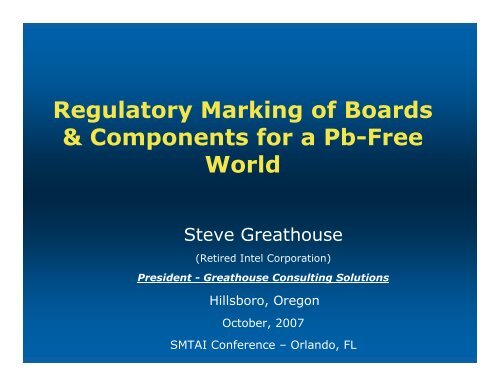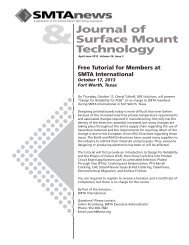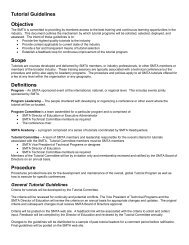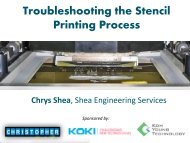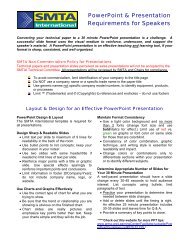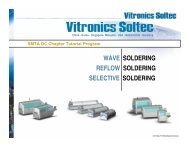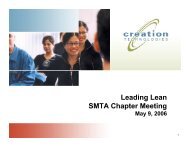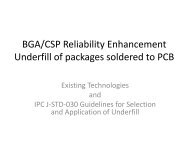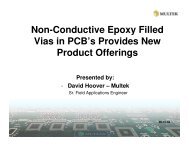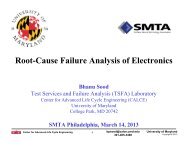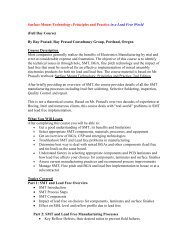Regulatory Marking of Boards & Components for a Pb-Free ... - SMTA
Regulatory Marking of Boards & Components for a Pb-Free ... - SMTA
Regulatory Marking of Boards & Components for a Pb-Free ... - SMTA
You also want an ePaper? Increase the reach of your titles
YUMPU automatically turns print PDFs into web optimized ePapers that Google loves.
<strong>Regulatory</strong> <strong>Marking</strong> <strong>of</strong> <strong>Boards</strong>& <strong>Components</strong> <strong>for</strong> a <strong>Pb</strong>-<strong>Free</strong>WorldSteve Greathouse(Retired Intel Corporation)President - Greathouse Consulting SolutionsHillsboro, OregonOctober, 2007<strong>SMTA</strong>I Conference – Orlando, FL
Agenda:• Purpose• Industry Specs• Board & Component <strong>Marking</strong>• Board & Box Labels• <strong>Marking</strong> Matrix• Actions2
The History <strong>of</strong> Lead RemovalRoman Cities – Used Water pipes, cooking pots, and storagecontainers made from lead. Some experts say this contributedto the downfall <strong>of</strong> Roman Empire. (Source <strong>of</strong> Low Alpha Lead) (Plumbism - <strong>Pb</strong> )– Elimination <strong>of</strong> lead through the years in the US:• Cosmetics – Removal began 1890’s - 1960’s• Household Paint – initiated in 1971- deadline 1978.• Cooking utensils & food storage items – 1979-83.• Lead-free Gasoline – 1973 trough the 1980’s.• Fishing weights, hunting ammunition – 1980 & mid 1990’s.• Solder in copper water pipes – 1990 - mid 2000’s.– And now:• Electronic components and systems – 2004 - 2007Beethoven3
Enviromental Issues Worldwide:The fast growing electronics industry is a sign <strong>of</strong> China’s wealth, but italso is a source <strong>of</strong> pollution that must be fixed. We can t af<strong>for</strong>d to pileup mountains <strong>of</strong> toxic junk.- Li Qia<strong>of</strong>eng , Executive Director, China National Resources Development Holdings Qia<strong>of</strong>eng,China is the worlds biggest growth country:• #1 consumer <strong>of</strong> grain, meat, coal and steel• #2 consumer <strong>of</strong> oilHowever, China is an “Environmental Nightmare”.• China has 5 <strong>of</strong> the worlds 10 most polluted cities.• Acid rain is falling on 1/3 <strong>of</strong> country.• 25% <strong>of</strong> citizens lack access to clean drinking water.• The World Health Organization has found that about 750,000 people dieprematurely each year from respiratory problems in China.– Air pollution from China is falling on Oregon and Washington coastlines.- Much <strong>of</strong> the particulate pollution over Los Angeles originates in China,according to the Journal <strong>of</strong> Geophysical Research.4
Electronic Waste in ChinaSo Why China RoHS?5
Electronic Waste in China6
Electronic Wastes in China & India:Women salvagingcomponents fromcircuit boards.7
Exponential Increase in Targeted Substances+4 Elements+45 Elements(Potential)11 Elements= 1980s new elements= 1990s new elements= 2000s new elementsCourtesy Julian LageardAs soon as scientific evidence is available…the prohibition <strong>of</strong> otherhazardous substances…should be examined – RoHS Directive8
Industry Specs Referenced JEDEC – JESD97, May 2004: <strong>Marking</strong>, Symbols, and Labels<strong>for</strong> Identification <strong>of</strong> Lead (<strong>Pb</strong>) free Assemblies,<strong>Components</strong>, and Devices. IPC-1066, June 2004: <strong>Marking</strong>, Symbols, and Labels <strong>for</strong>identification <strong>of</strong> Lead-<strong>Free</strong> and other reportable materials,in Lead-<strong>Free</strong> assemblies, <strong>Components</strong>, and Devices. Joint Standard J-STD-609 combines both the JESD-97and the IPC-1066 into one spec.Released – published (May 2007) www.jedec.org (<strong>Free</strong> download) www.ipc.org(<strong>Free</strong> download).JAPAN SPEC: JEITA ETR-7021, June 2004: Guidance <strong>for</strong> the Lead-free<strong>Marking</strong> <strong>of</strong> Materials, <strong>Components</strong> and Mounted <strong>Boards</strong>used in Electronic and Electric Equipment9
ROHS and WEEE DirectivesThe European Union's Restriction on Hazardous Substances (RoHS),includes a ban on lead in electronics that begun on July 1, 2006.WEEE – (Waste Electrical and Electronic Equipment) is the writtenDirective No 2002/96/EC <strong>of</strong> the European Parliament.• The WEEE restrictions are necessary to reduce the wastemanagement problems linked to the heavy metals and flameretardants found in ground water.========================================WEEE Take Back Policy:The WEEE directive encourages and sets criteria <strong>for</strong> the collection,treatment, recycling and recovery <strong>of</strong> WEEE.• It basically says: If you make it, you have to set up asystem to take it back and recycle, reuse, ordispose <strong>of</strong> it.10
ROHS Isn’t Just To Remove Lead:ROHS lists the following substancesSubstance Level by Weight:• Lead 0.1%• Mercury 0.1%• Cadmium 0.01%• Hexavalent Chromium 0.1%• Polybrominated biphenyls (PBBs) 0.1%• Polybrominated diphenyl ethers (PBDEs) 0.1%• Most components are controlled within the same range as <strong>Pb</strong>.11
Logo’s That Were Being Used By Other CompaniesNationalSemiconductor's logoE = Environmentally FriendlySamsungSony12
Eliminating the Lead in <strong>Components</strong>Flip-ChipBumpFlip-Chip Array(FC-PGA/LGA)High LeadBumpsocketCapacitorsLeadX^RoHS ExemptLGALandsFlip-Chip Ball Grid Array(FC-BGA)Flip-ChipBumpHigh LeadBumps^RoHS ExemptCapacitorsLeadXPrinted CircuitBoardROHS exemption <strong>for</strong> 1 st levelinterconnect bumps with>85% lead contentSolderBallsLead13XWire bonded deviceThis slidecontains builds
JEDEC Lead <strong>Free</strong> <strong>Marking</strong>Identification <strong>of</strong> Interconnect Material Differences2 nd Level Interconnect Materials – <strong>for</strong> packages and boards.Proposed Marke0e1e2e3Categorization and Material TypeBoard contains leadSnAgCu (any mixture) This is not included incategory e2.Sn alloys with no Bismuth or Zinc (excludesSnAgCu): (i.e. SnCu, SnAg, SnAgCuXTin Plate (all <strong>for</strong>ms)e4Precious Metals: Ag, Au, NiPd, NiPdAu (no Sn)e5Zinc containing: SnZn, SnZnx (no Bi)e6e7Contains any BismuthLow Temperature solder (
<strong>Pb</strong>-free Board <strong>Marking</strong>s- Bare Board Surface FinishBare Board Surface Finish Categories: The following codesshall be used to describe the surface finish on the bare board(prior to assembly):b0b1b2contains lead, traditional Sn<strong>Pb</strong>, hot air level orsolder reflowtin copper, or tin silver copper HASLimmersion silverb3b4b5b6b7, b8, b9tin (electrolytic or immersion)contains gold (immersion or electrolytic), ENIG,NiAuscreened carbonOSP (organic solderability preservatives)unassignedNOTE: The absence <strong>of</strong> a “b” code indicates bare copper with no surface finish.15
<strong>Pb</strong>-free Board <strong>Marking</strong>s- Halogen <strong>Free</strong> <strong>Marking</strong> Halogen <strong>Free</strong> marking: If the base materials used in making the bare printed boards are halogenfree,the label/marking “HF” shall be noted on the bare printed circuit board. If no “HF is present, a halogen containing base resin and rein<strong>for</strong>cementmatrix are assumed.• Halogen <strong>Free</strong>• IEC 61249-2-21: defines halogen free• 900 ppm maximum chlorine• 900 ppm maximum bromine• 1500 ppm maximum total halogensHFHalogen <strong>Free</strong> markFurther details at:www.halogenfree.ipc.orgwww.ipc.org/3.0_Industry/3.4_EHS/2007/IPCCommentsToEPEAT043007.pdf16
Intel <strong>Pb</strong>-<strong>Free</strong> Component <strong>Marking</strong>QFP 28x28aaQFP 10x10bdfcegQFP 7x7<strong>Marking</strong> location on package:– lower right <strong>of</strong> package or on bottom line.17
Board <strong>Marking</strong> Sequence UpdateHalogen<strong>Free</strong>HFb4BoardFinishe1SMTSoldere2e7WaveSolderLow TempSolder-If used.Rationale:The sequence <strong>of</strong> marks onthe board is in the orderthat the board was built -starting from the bareboard material (b4), SMT,Wave Solder, then lowtemp materials.<strong>Pb</strong>-free category marking sequence should be as follows:First position on the board specifies if the board is Halogen <strong>Free</strong>.Second position: shows incoming PCB surface finish.Third position: specifies Surface Mount Technology (SMT) solder pastecategory.Fourth position: specifies wave solder category, <strong>for</strong> example (e2) =Tin/silver.Fifth position: specifies if any low temperature solder was used on theboard.18
Board <strong>Marking</strong> Locations19Courtesy <strong>of</strong> Intel Corporation:
<strong>Pb</strong>-free Board <strong>Marking</strong>s– Mark PlacementThe guideline is that the marks be placed:1. On the lower right-hand corner <strong>of</strong> the board - if you are lookinginto the chassis from the top.2. On any easily read surface visible when the cover is open.3. If board is covered (ie. a film enclosure, etc), then the easiest toremove area should expose the board marking.4. Where possible, the board should NOT require removal from thechassis to determine if it is <strong>Pb</strong>-<strong>Free</strong>.1 stposition2 ndposition3 rdposition20
<strong>Pb</strong>-free Board Board <strong>Marking</strong>s- <strong>Marking</strong> Completely Lead <strong>Free</strong> ProductsFor products that are completely free <strong>of</strong> lead as defined by RoHS(.1% or
<strong>Pb</strong>-free Board Board <strong>Marking</strong>s- For <strong>Boards</strong> That Contain Some Lead.Lead-free requirement is to label boards with the <strong>Pb</strong>-free 2LI logowhich indicates the board meets RoHS lead requirements. RoHS leadexemptions (i.e., Flip chips, Ceramic capacitors, etc) allow lead in the firstlevel interconnect.CAD Library:• <strong>Pb</strong>-<strong>Free</strong> on board silk (Identifies board assembly has < 0.1% lead) –• 2 nd LVL INTCT on board silk (Identifies brd <strong>Pb</strong>-free at the 2 nd levelinterconnect) –Preferred Mark: –- CAD Symbol* “2LI” allowed <strong>for</strong>limited spaceproductsSorry, the initials “SLI” as an acronym cannot be used.“Trademark <strong>of</strong> Nvidia”22
Showing Compliance Through DocumentationAT LEAST TWO DIFFERENT DOCUMENTS ARE REQUIRED TO SHOWCOMPLIANCE TO RoHS DIRECTIVE:1. Supplier DocumentationAlso called – S-DoC affirmationsRequired <strong>for</strong> every vendor on every part2. Grind Test Lab Results- Required <strong>for</strong> every product23
Showing Compliance Through DocumentationEvery component used in a product must have an S-DoC• This includes Managed and Unmanaged components• Each S-DoC must include valid exemptions: (example)• S-DoC’s are available from each component supplier:BOM scrub required <strong>for</strong> every sku verifying SDoC’s• Every product family must have a Material Declaration Data Sheet(MDDS) – preferably available on your companies web site –available <strong>for</strong> download.– Includes a grind test– Includes a listing <strong>of</strong> all the claimed exemptions within the product24
<strong>Pb</strong>-<strong>Free</strong> Certification Packaging <strong>Marking</strong><strong>Pb</strong>-free certification markings on packaging must include the 2 nd levelinterconnect marking.Example <strong>of</strong> 10-pk box LabelExample <strong>of</strong> Retail Box Label25
<strong>Pb</strong>-<strong>Free</strong> Certification Packaging <strong>Marking</strong>•Component bag/box labelsShows finish category & max reflow temperature.26
Labeling Sustaining <strong>Boards</strong> (older product)For older boards that have beenin production, the new markingdirection will be followed byplacing “2Li” labels next to a <strong>Pb</strong>freemark.• Pre-printed labels placed on theboard• Pre-printed labels placed on retailbox27
Chin ROHS Mark Requirements- Became Effective on March 1, 2007China Recycling MarkChina RoHS table <strong>of</strong> declarationFirst: No restricted substances2 nd : Any substances above MCV valueNote:• Orange color is recommended, black and white logo is acceptable.• Logo size should not be smaller than 5mm X 5mm.• Font <strong>of</strong> the number in Logo is Impact, and the ratio <strong>of</strong> its height to inner and outer diameters<strong>of</strong> the circle is 5:8:12.• 10: indicates EFUP (Environmental Friendly Use Period) in years <strong>for</strong> the electronic in<strong>for</strong>mationproducts. (Years when product will begin to leachout – not end <strong>of</strong> functional life).MCV = Maximum Concentration Value28
To Sell products in China:Beware: EU RoHS substance exemptions don’t apply in China.• Language: Chinese required• English optionalPhase 2: Substance Restrictions• Catalogue administration:• If your product is in it, you must comply.• Additional products to be added periodically with some notice.Pre Pre-Market Testing Requirement• To verify that no homogenous material exceeds MCV <strong>for</strong> restricted materials• Tested by one <strong>of</strong> 19 China Certified labs.Actions: Stay aware <strong>of</strong> updates in the phases <strong>of</strong> implementation:• Determine Environmental Friendly Use Period• Determine packaging content• Produce Tables & Documentation in Chinese29
<strong>Marking</strong> Matrix – Component ProductsItemComponent<strong>Marking</strong>(Clause 6)Mark LocationComponent body,topside<strong>Marking</strong> or Labeling RequirementsRequired• Material category <strong>for</strong>component terminalfinish or material.OptionalMaximumComponent BodytemperatureComponentContainer LabelLowest Levelshipping containerAND any “ESD”, DryPack, or other bag orbox within theshipping container•Material category <strong>for</strong>component terminalfinish or material.•Maximum componentbody temperature•<strong>Pb</strong>-free symbol orphase “<strong>Pb</strong>-<strong>Free</strong>” (4.2)•2 nd level interconnectcomponent label (4.3)ESD BagsPre-printed on the bag•Appropriate <strong>Pb</strong>-freemarking is optional <strong>for</strong>boards which have markingon the board visible throughthe bag<strong>Marking</strong>Optional30
<strong>Marking</strong> Matrix – Board ProductsItemPCB <strong>Marking</strong>PCBAssembliesRetail salesbox (Prettybox)PCBAContainer label–Bulk BoxMark LocationTopside, lower righthandcorner or next topart./serial number orcompany logoTopside, lower righthandcorner or next topart./serial number orcompany logoOn the Barcode label orPre-printed on the box.Lowest Level containerholding the PCBA’s.<strong>Marking</strong> or Labeling RequirementsRequired•PCB surface finishcontaining lead (<strong>Pb</strong>) ifapplicable.•Halogen-free mark (HF)•Solders & Con<strong>for</strong>malcoating to be used byassembler•Mark with materialcategory <strong>for</strong> assemblysolder type(s) used inthe order <strong>of</strong> application(7.3)•Con<strong>for</strong>mal coating ifany.•Appropriate <strong>Pb</strong>-freemarking <strong>Pb</strong>-free/2nd lvlintct, & Halogen-free markif applicable.•Mark or label with thein<strong>for</strong>mation applicable tothe PCBA31<strong>Marking</strong> example<strong>Pb</strong>-<strong>Free</strong> symbolmarking or labelcannot be used ifany component isnot lead-free.
Product Certification <strong>Marking</strong>s- Country Specific <strong>Marking</strong>sRegionUSA/Canada<strong>Regulatory</strong>ComplianceSafety<strong>Marking</strong>EuropeUSASafetyEMCEMCE210882CanadaTaiwanEMCEMCCANADA ICES-003 CLASS BD33025AustraliaNew ZealandKoreaEMCEMCN232CPU - (product code) (B)JapanEMCCountry <strong>of</strong> OriginExportingRequirementsMADE IN xxxxx (Provided by label, not silkscreen)32
Summary <strong>of</strong> Requirements <strong>for</strong> all <strong>Pb</strong>-freeproducts: All <strong>Pb</strong>-<strong>Free</strong> products need to be marked accordingly on thecomponent, board, bag, shipping box, and retail box.1. Follow spec J-STD-609 Spec requirements.Download a copy from:www.jedec.orgwww.ipc.org2. Marks <strong>for</strong> each country are required <strong>for</strong> sales into those countries– China has their own specifications.3. Grind tests are required to determine true <strong>Pb</strong> levels in product.4. Worldwide sales require con<strong>for</strong>ming to world wide regulatory practices.5. Defense Supply Center Columbus (DSCC) position paper now proposes J-STD-609 as the commercial, aerospace, and military community marking standard.33
ReferencesReferences:Page: The Ira F. Brilliant Center <strong>for</strong> Beethoven Studieshttp://www.sjsu.edu/depts/beethoven/hair/hair.htmlBeethoven’s hair:http://www.sjsu.edu/depts/beethoven/hair/hairtestpc.htmlSpec Web site:www.jedec.org – <strong>for</strong> free download <strong>of</strong> J-STD-609 spec.www.ipc.org - <strong>for</strong> free download <strong>of</strong> J-STD-609 spec (temporarily)<strong>SMTA</strong> Web site archive:Presentation by Harvey Stone, “China ROHS, What we know & Don’t know.”34
Thanks <strong>for</strong> Your AttentionPlease feel free to contact us with any further questions:Steve Greathouse:Hillsboro, Oregon, 97123Contact Number (Phone) -503 372-5131Email: Greathouseconsulting@comcast.net35
Backup36
Legal direction on ROHS descriptionsHomogeneous Material:Means amaterial <strong>of</strong> uni<strong>for</strong>m composition that cannotbe mechanically disjointed into differentmaterials (where “mechanically disjointed”means that materials can, in principle, beseparated by mechanical actions such asunscrewing, cutting, crushing, grinding, orabrasive processes).37


